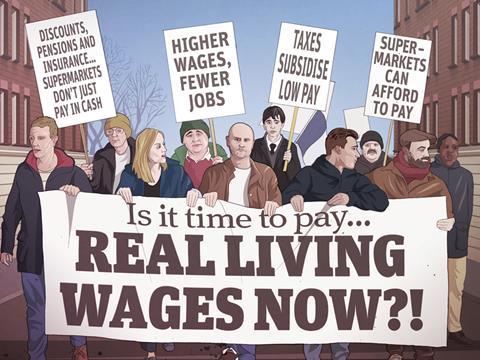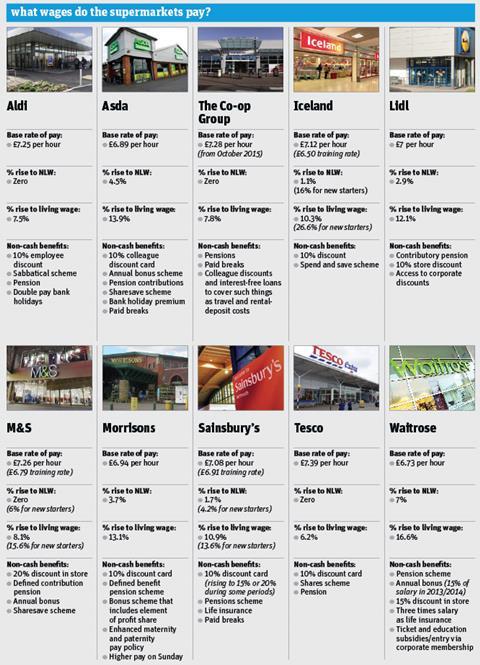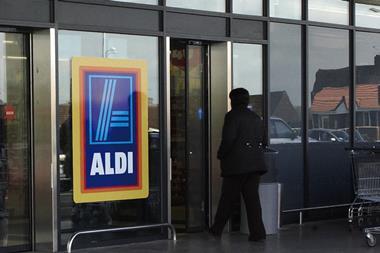
The introduction of a national living wage by George Osborne has only fuelled calls for a higher living wage to be paid…
Britain deserves a pay rise, and Britain is getting a pay rise,” proclaimed chancellor George Osborne as he delivered the Budget on 8 July. “I am, today, introducing a new national living wage.”
The Commons erupted. Secretary of state for work and pensions Iain Duncan Smith punched the air with both fists and yelled encouragement into the chamber as the UK digested the shock news, live on TV.
And it was a shocker. Not least for the struggling supermarkets, which were already coming under pressure from campaigners to pay the original living wage. So where does the new national living wage (NLW) leave that original living wage debate? What impact is its introduction likely to have on the supermarkets and other major retailers? And what’s the business case for them to go beyond the NLW now and become accredited as a living wage employer?
Under Osborne’s plans, as of April 2016 the NLW will require employers to pay all staff (aged over 25) a minimum of £7.20 per hour. That’s a 10% rise on the existing £6.50 minimum wage. And it’s going to rise further, to £9 per hour by 2020.
It’s a gutsy move, but Osborne’s proposal failed to placate campaigners calling for the real thing. Amid the roars of approval from his Cabinet colleagues, the sardonic hashtag #CallThingsTheLivingWageThatArent began trending on Twitter, with living wage supporters pointing out that while Osborne may have taken inspiration from the Living Wage Foundation in his terminology, he neglected to do the same with his calculations: his NLW is 65p short of the £7.85 per hour recommended by campaigners.
“I’m going to rename my kitten Living Wage. If Osborne can #CallThingsTheLivingWageThatArent, why can’t I?” tweeted Guardian columnist Owen Jones.
And that 65p cut isn’t the only difference. The original living wage, calculated annually by the Centre for Research in Social Policy, is “first and foremost based on what households require to enjoy a minimum acceptable standard of living” says CRSP director Donald Hirsch, who adds it also takes into account the state of the labour market, so “unrealistic requests” are not made of employers.
Why Cook pays the living wage

Cook released news of its living wage accreditation in the same week George Osborne launched his new national living wage, so you’d forgive it for feeling a little frustrated at the timing.
Social impact manager Charlotte Sewell is diplomatic, though. “We’re really proud that we’re supporting the Living Wage Foundation,” she says. “It’s really interesting to see it hit the news coverage over the Budget and it’s good that it’s being responded to, and on everybody’s minds.”
And she believes the “trustworthy” calculation of £7.85 per hour differentiates living wage-accredited employers from those choosing only to pay the compulsory NLW.
Prior to accreditation, Cook offered a base rate of pay of £7.39 per hour. The pay rise has impacted 352 people across the company, with 254 of these working in company-owned stores, and 91 of these in London outlets (and thus entitled to £9.15 per hour). So why did Cook make the change?
“Our products and our brand depend on our remarkable people,” says Sewell. “Service is really important to Cook because of its vertically integrated system of having all its own shops, so that’s key. It’s about what we stand for. There have been times when we were small and were growing, but we felt like we were in a position to do this because we’re financially stable.”
And as for the argument put forward by far larger retailers that their overall rewards packages of non-cash benefits make up for any shortfall in the hourly wage, Sewell says this “was taken into account, but when it came down to it we believed pay was primary. Our purpose is about using our business as a force for good.”
The NLW, however, has been “calculated directly with reference to what it is ‘safe’ to set as a minimum without risking jobs” he adds, so it settles on a lower threshold. Furthermore, the CRSP living wage applies London weighting, raising basic pay to £9.15 per hour, and applies to all workers over the age of 18, whereas the NLW doesn’t distinguish London from other regions and only applies to those aged 25 and over.
Despite these clear differences, Helen Dickinson, director general of the British Retail Consortium, hopes the government’s redefinition of a living wage “will end the abundance of disparate claims and bring some clarity to the issue. There has long been debate around what constitutes a ‘living wage’ with campaigners defining it to best suit their own ends.”
Yet if Dickinson, and the supermarkets, had hoped living wage campaigners might quietly drop their own £7.85 per hour calculations in the wake of Osborne’s announcement, they are mistaken.
Pile on the pressure
“We’ve been speaking with the 1,600 employers signed up to the living wage accreditation, and our allies, and our campaigners, and if anything the NLW has only highlighted the need for a cohort of leading employers to go further than the statutory minimum,” says Rhys Moore, director of the Living Wage Foundation. He confirms the foundation will “absolutely” continue to call on supermarkets to pay £7.85. In fact, far from easing off, he sees adoption of the compulsory NLW as the perfect opportunity to pile on the pressure.
“Why not see how we can go further?” he says. “Go for the higher voluntary wage.”
Major retailers are already facing growing pressure. Just last month, ardent supporters distributed embroidered handkerchiefs calling for the living wage to M&S board members, and tough questions were asked of Sainsbury’s CEO Mike Coupe at its agm the very next day. It followed 23,000 signatures collected on a petition for Tesco to implement the living wage at its 2014 agm, and similar demands of Morrisons and Asda.
This intense focus on the grocers makes perfect sense, believes Lisa Nathan, research and engagement officer at living wage-supporting charity ShareAction.
“The public have a strong relationship with their supermarket and they want to know that where they do their regular shopping treats their people right,” she says. “It’s an indication it will treat them right as customers, too.”
Backing up that claim is a study by KPMG released in June, which found 70% of adults would “consciously opt” to shop in a living wage-accredited store, a rise of more than 10% in less than 12 months. This level of public support is further reinforced by an exclusive survey carried out for The Grocer by Harris Interactive.

Its study of over 2,000 consumers found 88% welcomed the introduction of the NLW, with 44% believing supermarkets should voluntarily choose to pay above the new statutory minimum of £7.20 per hour delivered by the NLW. Three quarters of consumers also disagreed with the NLW only being applicable to workers aged 25 and over, as 84% felt it left the major grocers likely to purposefully increase their recruitment of those under the age threshold. And perhaps most significantly more than half (53%) would choose to do their grocery shopping at a living wage-accredited employer, rather than at a supermarket paying Osborne’s NLW.
Impact
The Harris Interactive findings make grim reading for the supermarkets, and if they are still reeling from the Budget almost four weeks on, it’s understandable.
The big four alone employ 684,000 people - some 2% of the UK working population. And none of them, or any other major food retailer for that matter, has a base rate of pay equal to, or above, that all-important £7.85 an hour delivered by the living wage.
According to the BRC, the average rate in retail for an hourly paid employee is £7.30 an hour, but our research suggests it averages just £7.09 an hour for the major grocers. Indeed, based on these figures all but Tesco, Aldi and The Co-op Group- which agreed a pay deal to take staff to £7.28 an hour as of October this year - will be affected by the introduction of the NLW (see box, above). Moving pay levels up to the NLW won’t come cheap. Julie Carlyle, head of retail at Ernst & Young, calculates Osborne’s Budget bombshell could see wage bills increase by as much as £9.6m per 100,000 employees.
The 50% increase in national insurance contribution employment allowance from £2,000 to £3,000 may help companies offset some of the additional cost of paying the NLW, adds Carlyle. But she also warns “many employers will not find it sufficient to fully cover the costs”.
A ‘morally wrong’ welfare system?
Growing pressure on retailers to pay fair wages was aggravated by revelations from campaign group Citizens UK in April this year, suggesting taxpayers ‘subsidise’ supermarket wages to the tune of millions of pounds a year via in-work tax credits.
It estimated that with 209,000 low-paid workers at Tesco, the retailer had workers’ pay supplemented by tax credits worth £364m each year. Among the big four it claimed an astonishing £956.7m in public funds propped up supermarket pay packets.
“Those numbers are a real surprise to people, and there’s a gut feeling supermarkets have a case to answer here,” says Rhys Moore at the Living Wage Foundation.
However, Helen Dickinson, director general of the BRC, argues “the design of the benefits system is the job of the government” and “those earning less than the living wage and receiving tax credits are different sets of people”.
More than 40% of those people earning less than the living wage, for instance, are in households in the top tier of overall income distribution, she points out.
One supermarket CEO says the current welfare structure is “a mess” and requires reworking to correct a “morally wrong” outcome in which full-time workers are subsidised by tax credits.
Moore is less convinced. “The tax credit system has been in place for over a decade and at no point have I heard any chief exec say we are concerned about the structural subsidy that is being created,” he says. “Where does responsibility lie ultimately? How do we ensure that people have sufficient income that they can live with some dignity? You have some very big profitable companies who are effectively receiving a subsidy. Their profits are being propped up through taxpayers.”
Yet while Dickinson accepts the UK has a low pay problem, she believes upping hourly wages is a blunt tool to solve it. “I think the solutions around low pay are in enhancing productivity and progression as opposed to in pounds and pence,” she says.
“The living wage is a neat headline-grabber and what we’re describing is a much more complex problem to unpick than saying ‘pay everybody more’.”
The better news for supermarkets is that the BRC says a third of supermarket staff are under the age of 24 so they fall outside the NLW remit. But it will still be “painful” believes Iceland CEO Malcolm Walker, who wrote to all his staff on 10 July saying the retailer would scrap training rates of £6.50 an hour as of this month, with the NLW adopted for all staff as of October, six months ahead of Osborne’s deadline.
Speaking to The Grocer, Walker accepts the NLW “will have a big cost. There’s no two ways about that.”
And those inevitable extra costs hit Walker’s listed rivals where it hurt just minutes after Osborne’s announcement: Sainsbury’s shares fell by 1.1%, Morrisons by 1.5% and M&S by 2.5%.
“The major difference is that Iceland is a private company and if our profits are down a bit it doesn’t matter,” adds Walker. “If profits are down a bit at a public company the world ends.”
The wage bill
Listed or not, all affected grocers will have been calculating how best to offset the increase in their wage bill, says Sven Reinke, vice president and senior credit officer at Moody’s.
“Wages are a big chunk of their cost structure,” he says. “A good estimate is that 10% of sales equates to the wage bill for a supermarket. That’s why the news has material impact.”He adds the bill will be highest for the service-centric models of the big four, plus Waitrose and Marks & Spencer, with the discounters faring a little better thanks to their inherently efficient and less labour-intensive structure.
One “logical and natural way” of adjusting for that increased bill would be to push up prices for consumers, Reinke adds, but in the midst of a price war what sane retailer would consider that?
“You can’t,” shrugs Walker. “It’s a competitive marketplace. We’ve just got to take the pain.”
And moving above and beyond the NLW to the living wage would pile on additional pain. A pay rise to £7.85 per hour could reach £2,400 per employee, per year. That’s made up of additional wages, national insurance and corporate tax, where the lowest paid are currently on £6.50 per hour. However, that figure will fall for over-25s once the statutory minimum of £7.20 comes into force in 2016.
Having said that, these calculations don’t even account for the inevitable knock-on effect upwards, points out Janette Lucas, employment partner at law firm Squire Patton Boggs.
She believes supervisory staff will expect the margin between their own pay and that of lower ranking staff to be “meaningful”.
And with underlying profits at major food retailers in worrying decline, the result of this 20% pay rise for thousands of low-paid workers could be “absolutely catastrophic” warns a senior supermarket source. Profitability, he warns, would be “wiped out in one go” if the living wage were adopted by a big grocer.
Walker said as much to staff in his letter just days after the Budget.
“It is generally accepted a more generous rate of £7.85 will provide a living wage,” he wrote.
“Over recent weeks we have been exploring ways of moving our pay rates upwards to meet that target. Most of you will be aware that due to a really tough marketplace our profits last year dropped by a third. It doesn’t leave us much room for manoeuvre on pay and such an increase would make a dent in our cashflow that would be impossible to live with.
It’s why any decision to adopt the living wage must be taken over time, believes Nathan, although she accepts that it’s a “challenging time. It’s frightening to be the company that steps forward and tells shareholders they’re going to take this short-term upfront cost and wait for long-term benefits

And with time not afforded to them by the NLW, which comes into force in just eight months’ time, grocers can offset costs by “working with their supply chain and suppliers,” suggests Michael Kelly, head of the living wage at KPMG.
“Work with your long-term suppliers in the same way you would do with any other management issue and it becomes a shared objective.”
Improved morale
What retailers mustn’t forget to factor in either, Nathan adds, is the financial gains accrued from paying higher staff wages.
She’s backed up by the fact that nearly a quarter of the FTSE 100, as well as global food and drinks manufacturer Nestlé, have moved to living wage accreditation, suggesting there is a sound business case for doing so.
And a survey of living wage employers by the Greater London Authority carried out in 2014 found 80% of those questioned believed paying the living wage had enhanced the quality of work performed by staff, based on “positive employee retention and turnover, reduced absenteeism, improved morale and increased productivity”.
How will the NLW affect indies?
To say indies are unimpressed by George Osborne’s Budget would be an understatement. Association of Convenience Stores CEO James Lowman says he finds it “appalling” the chancellor ditched the process by which the Low Pay Commission recommends rises in the minimum wage.
“It’s an astonishingly arrogant move to take with very little thought about the impact on hardworking businesses that many people thought would be at the heart of this government,” he says, adding that for c-stores, the cash impact of the national living wage could reach £20,000 per year.
The ACS claims as many as 24,000 stores and 80,000 jobs could be put at risk by the pay rise to £7.20, with many independents spending about 12% of their total costs on staffing.
Research carried out by the ACS estimates the pay rise could cost the convenience sector £166m.
Some stores have already vowed to close as a result of the Budget announcement, says Lowman, though he believes most will seek to offset costs by other means with ensuing “knock-on effects” across the sector.

“They may cut opening hours, they might ditch some services that are particularly labour-intensive and they might delay some investments, all which may or may not save the business.
”This fallout from Osborne’s announcement follows a warning by John Allan, national chairman of the Federation of Small Businesses, that any living wage must remain “a voluntary goal” for small businesses.
“The Living Wage is, and should remain an important aspirational goal for firms to strive for,” Allan says.
He points out 53% of small businesses already pay the living wage of £7.85 per hour, or above, and “are recognising the benefits to their business in terms of staff morale, performance and recruitment”.
However “a mandatory living wage would pose considerable risks to small businesses in certain sectors, especially retail and health and social care”.
He adds: “We want government to reduce other business costs, which would enable small firms to pass on the savings to their staff in the form of higher wages.”
Furthermore, as ShareAction points out in its recent investor’s briefing, the up-front cost of paying the living wage can be seen as “relatively modest in comparison with the potential risk of pay-related reputational damage, particularly for consumer-facing businesses.All these mitigating factors, believes the charity, show that even for a major retailer, adoption of the living wage would result in only a single-digit net earnings reduction, between 1% and 6% of corporate earnings, for the sample companies it selected.
Yet another nagging concern for retailers - and for staff - is that any additional cost caused by higher wages could mean fewer jobs.
The Association of Convenience Stores believes more than 80,000 jobs could be put at risk among its members (see box, over) and though no supermarket has openly voiced similar concerns, the assumption by critics remains that both jobs and job promotions could be put at risk by higher basic pay.
However, the evidence just isn’t there, argues Howard Reed, who researched the economics of adopting the living wage for Unison in late 2014.
He claims previous increases to the national minimum wage have produced no evidence of substantial impacts on the labour market.
He admits little data is available on lifting levels by 20% (the jump from £6.50 to £7.85), but says the data that does exist is “still comparable with some of the other OECD countries, towards the top end. And for most of the countries in the OECD there’s no evidence that increases in wages lead to loss of jobs.”
In fact, Reed claims the opposite may be true for grocers. “The increased living wage could lead to an economic stimulus. Those receiving it are more likely to spend extra money as a result. That has a positive feedback in the economy, leading to businesses taking on more workers.”
Further concerns for retailers regarding staff employed via contractors, given the indirect employment relationship, can also be overcome, believes Kelly. He says employers accredited via the Living Wage Foundation can look to phase in adoption for contracted workers to avoid rushed contract renegotiations.
“If you’ve just signed a three-year service contract and then go and move to accreditation, you don’t want to unpick a contract you’ve just put to bed,” he says. “So you would wait for a review period and agree with the Foundation how you would phase it in, and what are the milestones.”
The Foundation points out it can provide “considerable support” on this extra step, offering up a list of 1,500 accredited employers, many large-scale businesses, as testament.
Rewards
Practicalities aside, for Nathan at ShareAction one of the key obstacles that prevents supermarkets making the leap is neither additional cost or job losses, but “an ideological opposition based on their arguments about having a wider rewards package”.
All the major grocers offer staff in-store discounts with pensions, life assurance, profit-share schemes, subsidised healthcare, and leisure activities thrown in - a pick and mix of rewards they say pushes their value of pay above hourly wages.
If you end up in a situation where your base salary cost is going up it is inevitable other benefits that create cost will be sacrificed
And yet “everybody looks at the headline pay number rather than the total reward” says a frustrated Dickinson. “All the supermarkets undertake regular employee surveys on their terms and conditions, and they’ve all built a package tailored to the needs of their particular business.”
Lucas at Squire Patton Boggs warns these benefits could already be in the line of fire as a result of the added cost of the NLW. “It’s inevitable,” she says. “There is a limited amount of money in the pot and these supermarkets can only invest so far. If you end up in a situation where your base salary cost is going up it is inevitable other benefits that create cost will be sacrificed.”
A senior source at one of the major mults confirms “a rewrite of these arrangements” is inevitable as all additional costs are under scrutiny.
And yet, say retailers, campaigners for the living wage often dismiss the value of this overall rewards package, which would be left even more vulnerable were the supermarkets to adopt the £7.85 per hour living wage rate.

“The challenge with the Living Wage is that those benefits aren’t taken into account when accumulated together and they are incredibly popular with our colleagues,” Mike Coupe, CEO of Sainsbury’s told the supermarket’s agm in July.
In addition to a base rate of pay of £7.08 per hour, Sainsbury’s provides staff with a 10% discount card, pension, life assurance, paid breaks and annual bonus.
“I think the living wage campaign needs to be more thoughtful about all the benefits we offer our colleagues,” believes Coupe. “If we improve the base rate of pay it has to be paid from somewhere and if we take popular benefits away to improve it I don’t think that will be the right thing to do.”
Moore concedes there is “absolute value in many of those benefits and we know many workers appreciate them.”
And he says the Foundation is currently consulting on the benefits question to understand if it may, in future, take a more holistic look at overall benefits packages, in particular those benefits that literally put “food on the family table”.
And he says the Foundation is currently consulting on the benefits question to understand if it may, in future, take a more holistic look at overall benefits packages, in particular those benefits that literally put “food on the family table”.
But, he also asks, “why not give your employees a choice? If you’re confident that your benefits packages are so valued then why not offer a choice to your workforce? And, so far, none of the supermarkets have been drawn to that idea.”
Pushed on why he would not offer a choice, Coupe said the retailer was currently “spending a lot of money” on “systems to do a better job on a number of fronts on communicating with colleagues and building flexibility for them” when it came to choosing benefits.
“But,” he added, “I think most would vote for the discount card for what it’s worth.”
Leadership
As all major retailers - and businesses across all sectors, for that matter - come to terms with Osborne’s audacious addition to the 2015 summer Budget, the question of who will join the likes of Ikea and pay staff the real living wage shows no signs of dissipating.
Moore believes “the first mover” in grocery will emerge in the next 12 months, though a director at one of the big four dismisses any such notion as “naïve”. And no major retailer will comment openly on its future plans above and beyond stating they will, of course, comply with the new NLW.
“The big four have been considering it very seriously for quite some time,” believes Nathan. “But logistical changes to the payroll system would take time, so I wouldn’t be surprised to see an Aldi or Lidl beat them to it. Which would be a real shame for the supermarkets.”
We are ready for the change to the national minimum wage and will continue to actively demonstrate our ongoing commitment to our employee
All a Lidl spokesman will say is “we are ready for the change to the national minimum wage, as announced by the chancellor in last week’s budget, and will continue to actively demonstrate our ongoing commitment to our employees.”
In a similar vein, Tony Baines, joint MD of corporate buying at Aldi, will only say “we continually review and evaluate pay rates and are investing significantly in recruiting and training new employees as we aim to create 35,000 new jobs across the UK by 2022.”
Although it was a shock, Moore believes the NLW presents the ideal opportunity for grocers to take the lead on the fair wages debate and become accredited.
“If anything it should make the business case easier for them,” he says. “They can show they are employers who don’t just cling to a statutory minimum. They employ more people than anybody else on less than the living wage. And if we’re to see a significant change in the low pay economy in this country, then we need to have some leadership shown by the supermarkets.”




















No comments yet